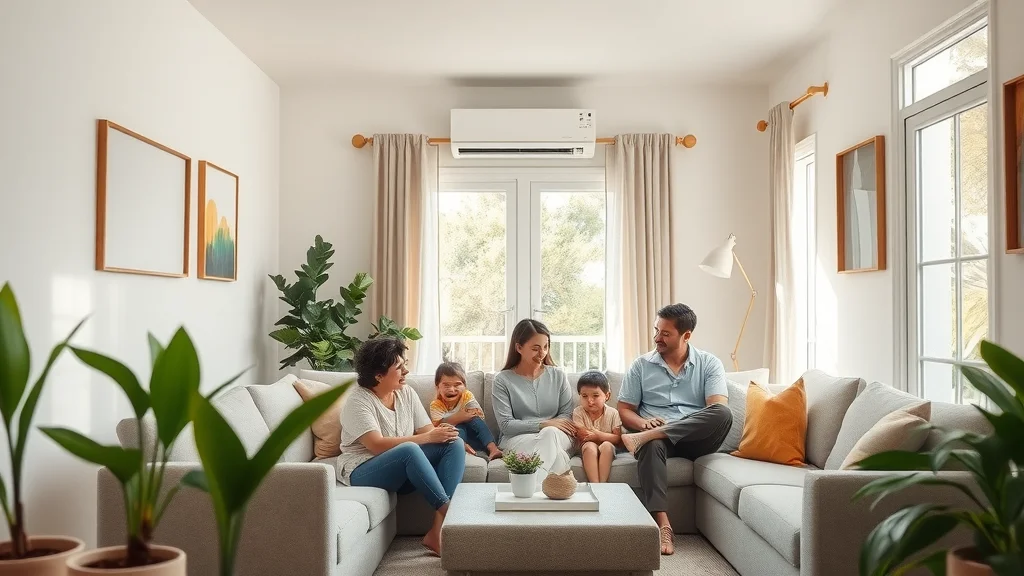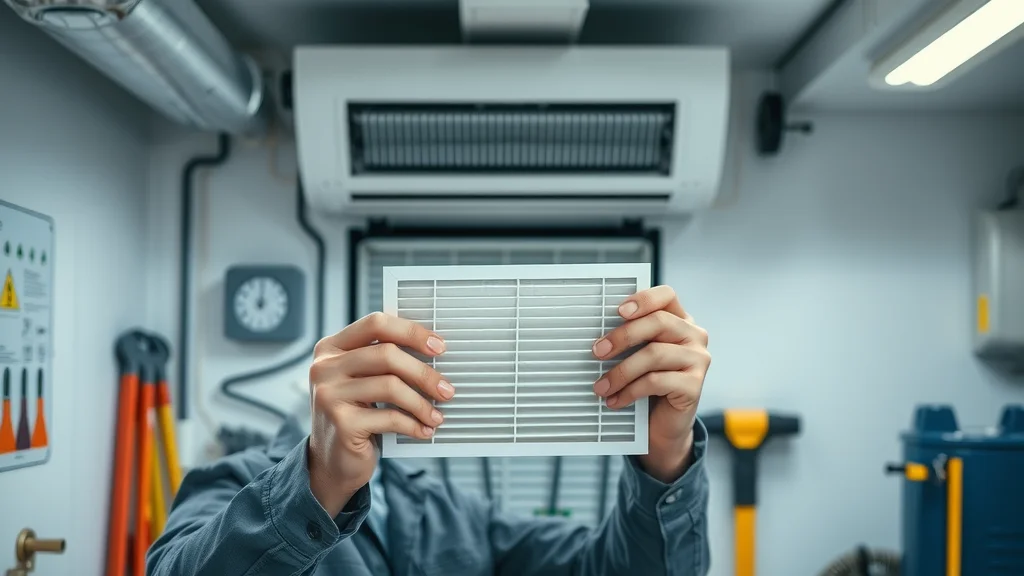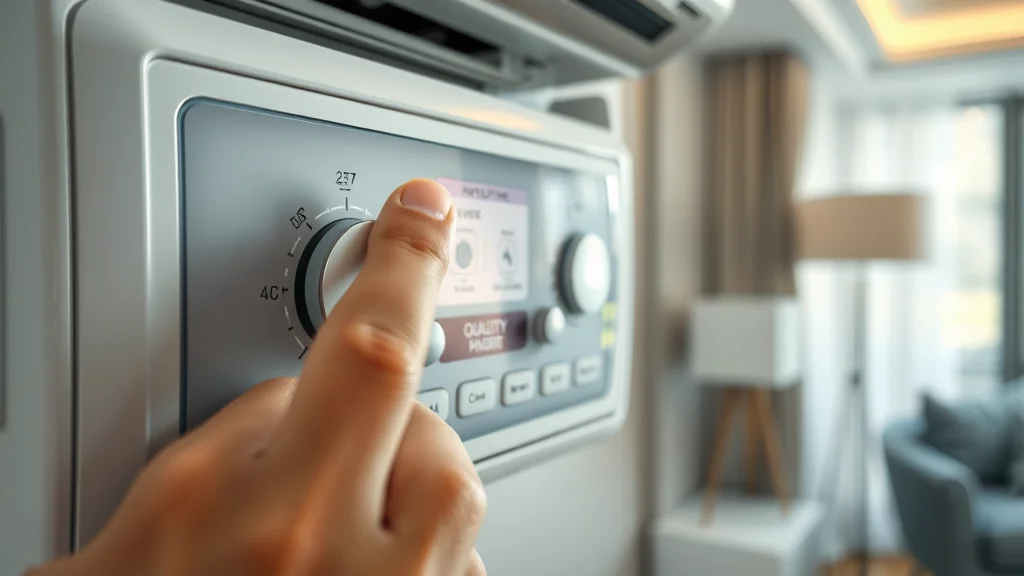Startling fact: According to the CDC, nearly 25 million Americans live with asthma, and poor indoor air quality from HVAC systems can significantly worsen symptoms. If you or your loved ones experience asthma, the right air conditioning unit can be the key to a healthier, more comfortable home. In this detailed guide, you’ll discover everything you need to know about asthma symptom management AC units—how they impact air quality, reduce asthma triggers, and which features matter most for your family’s wellbeing.

Breathe Easy: The Surprising Connection Between Asthma Symptom Management AC Units and Indoor Air Quality
Choosing the right asthma symptom management AC units directly affects indoor air quality and, ultimately, the health of everyone in your household. Air conditioners aren’t just about comfort—they’re an essential part of controlling the allergens and particles that often trigger asthma symptoms. When combined with high-performing HEPA filters and proper maintenance routines, air conditioning becomes a frontline defense against dust mites, mold spores, and other common irritants found inside your home.
Many people underestimate how much indoor air quality and HVAC systems are intertwined. While a cutting-edge central air conditioner or a targeted portable air conditioner can significantly reduce asthma triggers, neglected units might inadvertently circulate dust, pollen, and even mold. Whether you’re managing your own symptoms or those of a family member, understanding the capabilities and maintenance requirements of your AC is a vital part of effective asthma management.
Startling Asthma Facts: How Air Conditioning May Affect Asthma Triggers
Asthma currently affects nearly 1 in 13 Americans—a number that continues to rise. Homes without adequate air purification measures often foster environments where dust mites, mold spores, and other allergens freely circulate, unpredictably provoking asthma attacks. On the other hand, advanced air conditioners equipped with HEPA or high-quality filters can trap up to 99.97% of airborne particles that commonly trigger asthma. This means the right HVAC setup isn’t just a preference—it’s a medical priority for individuals aiming to breathe easier, reduce shortness of breath, and lower the risk of acute episodes.
“According to the CDC, nearly 25 million Americans have asthma, and poor indoor air quality from HVAC systems can significantly worsen symptoms.”
What You’ll Learn About Asthma Symptom Management AC Units
- How HVAC system choices impact asthma management
- Features in air conditioners that best control asthma triggers
- Types of air filtration systems and their efficacy
- Portable air conditioner and air purifiers for targeted symptom relief
- Expert tips for maintaining your air conditioning and improving indoor air quality
Understanding Asthma Symptom Management AC Units: Key Concepts
Defining Asthma Symptom Management and HVAC System Roles
Asthma symptom management involves a proactive approach to minimizing exposure to airborne irritants, regulating humidity, and keeping the air in your home clean and safe for all residents. Your HVAC system—including both heating and cooling components—plays a fundamental role in this process. Not only do modern air conditioners regulate temperature, but with the right filters and upkeep, they also remove a significant volume of allergens that trigger asthma and negatively affect the immune system.
Whether it’s central, window, or portable air units, understanding how each system circulates and cleans your indoor air allows you to make informed choices. Today’s top air conditioning technology features enhanced filtration, smart humidity control, and features that specifically address common asthma triggers, so selecting the right unit can be a real game changer for people with asthma.

Why Air Conditioners and Air Conditioning Impact Asthma Management
Air conditioners aren’t just about keeping you cool; they manage both temperature and indoor air quality. Efficient filtration systems in AC units trap dust, pollen, pet dander, and mold spores before they ever reach your lungs. Central HVAC systems with HEPA or electrostatic filters can dramatically improve home air standards, especially when compared to older AC models or units without regular filter changes.
But not all AC units are created equal. While central air systems typically offer superior filtration and whole-home coverage, portable air conditioners work well in small spaces but may lack advanced filters. The key is matching your home’s needs and asthma management goals with the right balance of filtration strength, upkeep, and coverage.
| HVAC System Type | Filtration Efficiency | Impact on Indoor Air Quality | Asthma-Friendliness |
|---|---|---|---|
| Central AC | High (w/ HEPA) | Excellent | Excellent |
| Portable Air | Moderate | Localized Improvement | Good |
| Window Units | Variable | Moderate | Fair |
HVAC Systems and Indoor Air Quality: A Crucial Link for Asthma Management
Indoor Air Quality: Common Asthma Triggers at Home
The air in your home might look clean, but it frequently contains microscopic particles that can silently harm those with asthma. Among the most common asthma triggers lurking indoors are dust mites, mold spores, pollen, pet dander, and harmful volatile organic compounds (VOCs). These irritants, often trapped in soft furnishings and carpeting, become airborne due to foot traffic or the operation of your HVAC system, challenging your body’s immune system and potentially triggering symptoms like coughing, wheezing, or shortness of breath.
- Dust mites
- Mold spores
- Pollen
- Pet dander
- Volatile organic compounds (VOCs)

How Air Conditioners and Filtration Systems Reduce Asthma Triggers
Equipped with specialized filtration systems, the right air conditioners can significantly reduce or even eliminate many common asthma triggers from your indoor environment. HEPA filters, for example, are effective at capturing tiny particles such as pet dander, dust, mold spores, and pollen—substances known to provoke the immune system and trigger asthma attacks. In central HVAC systems, filters should be replaced every 60–90 days or more frequently if you have pets or live in a high-pollen area.
It’s important to properly maintain your units. A neglected HVAC system can become a breeding ground for mold if high humidity isn’t controlled, and clogged or dirty filters can start to recirculate allergens rather than trap them. Regular maintenance, high-quality filters, and well-designed air flow dramatically improve indoor air quality—making every breath safer for people with asthma.
Types of Asthma Symptom Management AC Units: Central, Portable, and More
Central HVAC Systems: Whole-Home Asthma Management
Central air systems remain the gold standard for managing asthma and allergies throughout an entire home. By integrating with ductwork and utilizing high-grade filters, central HVAC systems allow for the addition of whole-house air cleaners, humidifiers, and even UV-C germicidal lights. This setup ensures every room receives consistently filtered and conditioned air, minimizing the risks posed by localized allergens such as pet dander and dust mites.
Not only do well-maintained central systems filter out airborne particles, but they’re also more effective at balancing humidity—a critical factor in controlling mold spores and minimizing triggers. Proper zoning, periodic professional cleaning, and use of smart thermostats all further enhance their effectiveness for asthma symptom management.
Portable Air Conditioners for Targeted Asthma Relief
For those seeking more flexibility or only need cooling and filtration in select areas, portable air conditioners provide a practical solution. These units offer localized relief, making them ideal for bedrooms, nurseries, or home offices where a family member may spend the most time. Portable ACs are also perfect for renters or those living without traditional ducts.
When evaluating a portable air conditioner for asthma, look for units with advanced filters (preferably HEPA), easy access for cleaning, and proper moisture control to discourage mold growth. Although portable units may not match the overall efficiency of central HVAC systems, their targeted approach can make a notable difference in indoor air quality for asthma sufferers.
Air Purifiers and Supplementary Filtration Systems
In addition to AC units, standalone air purifiers offer an extra line of defense against airborne irritants. These devices use HEPA, activated carbon, or even UV-C light technologies to neutralize and capture particles that trigger asthma reactions, working alongside your primary air conditioner or HVAC setup. Supplementary filtration is particularly helpful in homes with pets, where dander and fur can otherwise circulate uninterrupted.
Even if you have a high-end central air system, adding portable purifiers to specific problem rooms creates an environment far less likely to instigate allergic or asthmatic reactions. Advanced models even detect air quality and adjust operation accordingly, giving you smarter, cleaner control of your indoor air.
Explainer: Comparing AC Unit Types for Asthma Symptom Management
Choosing the Right AC Unit for Asthma Symptom Management
Critical Features in Air Conditioners for Allergy and Asthma Sufferers
When shopping for an asthma symptom management AC unit, certain features make a significant difference for asthma and allergy control:
- HEPA Filtration
- Humidity Control
- UV-C Light Technology
- Easy-to-Clean Filters
HEPA filters excel at removing even the smallest particles—including dust mites and mold spores—which are otherwise hard to eliminate from indoor air. Humidity control is essential because high humidity fosters the growth of allergens, especially in warm, moist regions. UV-C light is emerging as a technology to neutralize germs, bacteria, and potential viral contaminants within the air conditioning system. Allergen sufferers should also prioritize units with accessible, easy-to-clean filter housing to ensure regular maintenance is quick and effective.

Energy Efficiency vs. Air Quality: What Matters Most?
While energy efficiency is high on many homeowners’ wish lists, it should never come at the expense of improved air quality for those with asthma. Fortunately, many of today’s ENERGY STAR-certified air conditioners feature both low energy consumption and advanced filtration. The real key is to read the specs: verify filter ratings, look for allergen-removing technologies, and ensure that upgrades for efficiency don’t compromise your system’s cleaning power.
Combining energy-smart programming with enhanced indoor air quality features not only keeps utility bills in check but ensures the environment inside your home actively supports asthma management. Always choose models that allow upgrades to premium filters or whose cycle and fan settings support longer, more effective cleaning when allergens peak.
Best Practices for Maintenance of Asthma Symptom Management AC Units
Replacing Air Conditioning Filters: How Often and Why It Matters
The effectiveness of asthma symptom management AC units hinges on replacing air filters at the right intervals. For those with asthma or severe allergies, experts recommend changing filters every 30 to 60 days. Dirty or clogged filters quickly lose their ability to trap allergens, allowing irritants to recirculate throughout your living space. This not only negates all the benefits of your advanced AC system but risks health complications for vulnerable family members.
Set calendar reminders or use smart system notifications to stay on top of filter changes, especially during high-pollen seasons or if you have pets. Regularly inspecting filters also helps catch signs of mold or excess buildup—both urgent indicators that your HVAC system needs attention for clean, safe air quality.
Cleaning Strategies to Prevent Mold and Asthma Triggers in HVAC Systems
Even the best filters can’t fully protect you if there’s mold growth inside your HVAC ducts or on condenser coils. Mold spores thrive in areas with moisture and minimal airflow, so it’s critical to schedule annual professional inspections and cleanings. Sometimes, all it takes is a clogged drain pan or unchecked leak to foster mold, meaning a minor oversight could soon threaten your indoor air quality and asthma management efforts.
Make sure to follow your manufacturer’s cleaning recommendations, dry out humid areas promptly, and run “fan-only” settings periodically to keep the ductwork free from still air. DIY cleaning—such as vacuuming registers or wiping down accessible vents—also supports daily efforts to limit asthma triggers.

Instructional: How to Maintain Your HVAC System for Optimal Asthma Management
Expert Insights: Improving Indoor Air Quality for Asthma Management
“Routine maintenance of HVAC systems and careful selection of air filtration are among the best steps homeowners can take to manage asthma symptoms effectively.” – Dr. Emily Hayes, Pulmonologist
Professional Recommendations for Air Conditioner Upgrades
Consulting with HVAC professionals is always a wise investment, particularly for homes with severe allergies or persistent asthma symptoms. Specialists assess everything from duct integrity and unit placement to filter compatibility and humidity risks. Many recommend adding whole-house humidifiers and dehumidifiers, advanced HEPA filtration, and periodic duct cleanings for comprehensive protection.
If you’re upgrading an existing AC or choosing a new asthma symptom management AC unit, request an air quality audit as part of the service. This allows you to tailor your system—large or small— to your family’s unique needs, ensuring both efficiency and wellness. Upgrades, while sometimes costly, often pay off in reduced medication use, fewer asthma attacks, and a noticeable uptick in your overall comfort at home.

People Also Ask About Asthma Symptom Management AC Units
Is AC harmful for an asthma patient?
While properly maintained AC units with quality filtration can improve indoor air quality and reduce asthma triggers, neglected systems may accumulate dust and mold, possibly exacerbating asthma symptoms.
Can you do HVAC with asthma?
Yes, individuals with asthma can safely benefit from HVAC systems, particularly those with advanced filtration and regular maintenance practices that enhance indoor air quality.
Can asthma patients use an air cooler?
Air coolers are generally less effective than air conditioners for asthma management, as they may introduce moisture and potentially distribute mold spores if not properly maintained.
Does cool air help an asthma attack?
For some, cool air from an AC unit can help provide comfort during an asthma attack by reducing humidity. However, overly cold or dry conditions may act as a trigger for others. Personal preference and symptom response should guide use.
Frequently Asked Questions on Asthma Symptom Management AC Units
How often should filters be changed if you have asthma?
For effective asthma symptom management, filters should be changed every 30 to 60 days, or more frequently if you live in a high-pollen area or have pets. Regular filter replacement ensures your air conditioner continues to trap allergens like dust mites, pollen, and mold spores—critical for keeping your indoor air clean and your asthma symptoms minimal.
What types of filters are best for asthma symptom management ac units?
HEPA filters are the top choice for asthma symptom management AC units as they capture up to 99.97% of particles as small as 0.3 microns, including dust, pollen, pet dander, and mold spores. Electrostatic and activated carbon filters also provide strong filtration, especially when targeting gases, VOCs, or very fine particles.
Are portable air conditioners effective for asthma management in small spaces?
Yes, portable air conditioners offer reliable relief for asthma management in small spaces, provided they use quality filters (ideally HEPA) and are properly maintained. These units are especially useful in bedrooms, nurseries, or offices and can help create targeted zones of clean air, especially where central HVAC is not an option.
Key Takeaways for Asthma Symptom Management AC Units
- Selecting the right air conditioner and HVAC system directly influences indoor air quality and asthma triggers.
- Regular maintenance and high-quality filters are essential for asthma management.
- Portable units can provide localized relief but may not match central systems in efficiency.
Ready to Improve Your Indoor Air?
Local Business In the Eustis Area? Reach out to us to advertise and reach thousands of local home owners!
Conclusion: Upgrading your asthma symptom management AC units and following best practices for maintenance creates a healthier, more comfortable indoor environment. Start breathing easier today by investing in cleaner air!
Selecting the right air conditioning unit is crucial for managing asthma symptoms, as it directly influences indoor air quality by filtering out allergens and controlling humidity levels. For instance, the Dyson Pure Cool TP04 combines HEPA filtration with cooling fan functionality, effectively removing airborne pollutants while providing comfort during warmer months. (airpurelife.com) Additionally, Daikin’s air conditioners are recognized by the National Asthma Council Australia’s Sensitive Choice program for their advanced filtration systems and smart humidity control, making them a top choice for asthma and allergy sufferers. (aircondinstallswa.com.au) If you’re serious about improving indoor air quality to manage asthma symptoms, these resources offer valuable insights into suitable air conditioning options.

